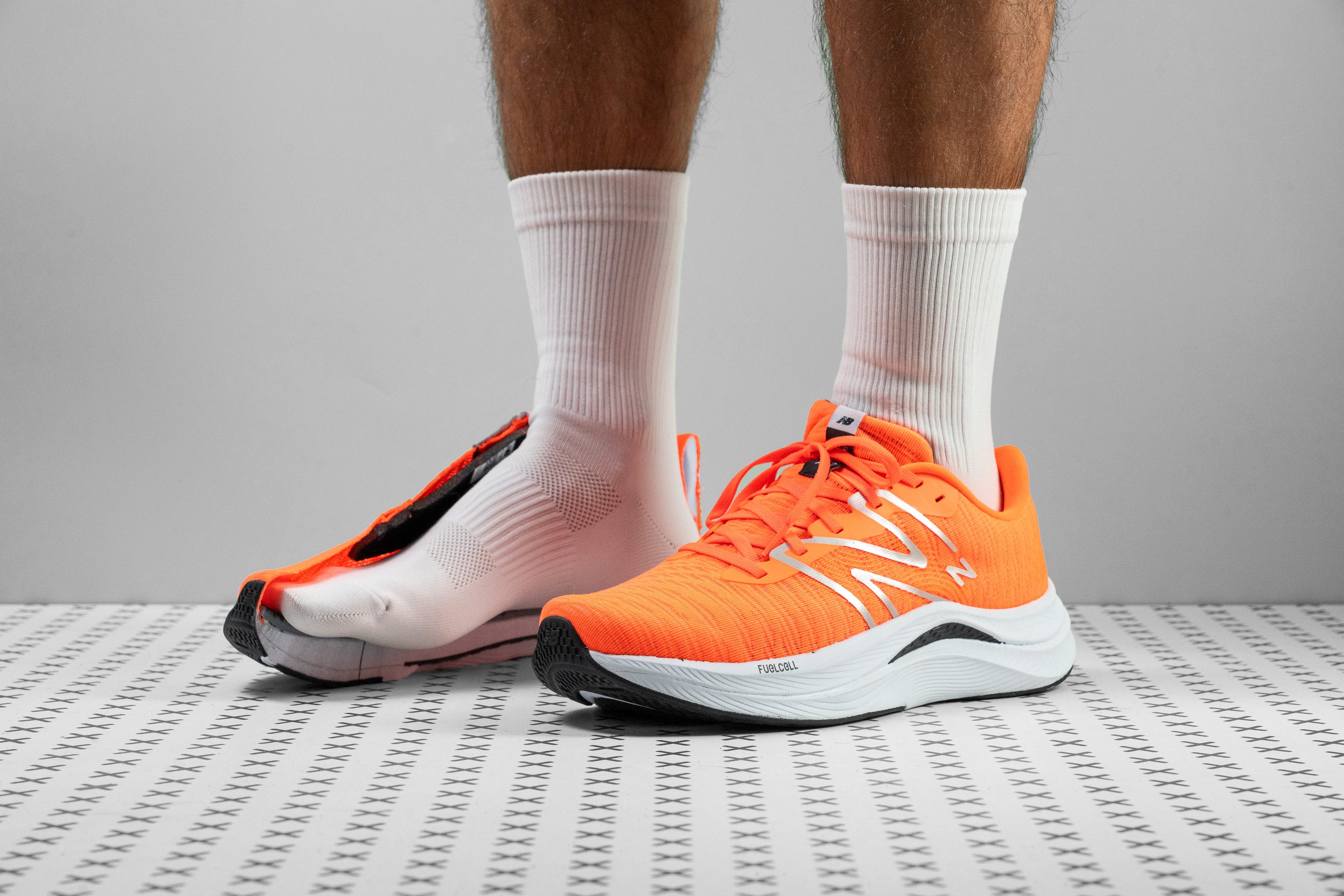Our verdict
Pros
- High-quality upper material
- Ultra-cushioned FuelCell midsole
- Seamlessly integrated TPU plate
- Versatile for both easy and tempo runs
- Long-lasting outsole
- Perfect for midfoot and forefoot strikers
- Exceptional value at just $110
- Grippy outsole
Cons
- Not the best for heel strikers
- Stability concerns
Audience verdict
Comparison
The most similar running shoes compared
+ + Add a shoe | |||||
|---|---|---|---|---|---|
| Audience score | 86 Good! | 92 Superb! | 85 Good! | 80 Good! | |
| Price | $110 | $125 | $140 | $120 | |
| Pace | Daily running | Daily running | Daily running | Daily runningTempo | |
| Shock absorption | High | High | Moderate | High | |
| Energy return | Moderate | Moderate | Low | Moderate | |
| Traction | High | Moderate | Moderate | Moderate | |
| Arch support | Neutral | Neutral | Neutral | Neutral | |
| Weight lab Weight brand | 9.7 oz / 276g 10.7 oz / 302g | 10.1 oz / 285g 9.7 oz / 275g | 10.5 oz / 298g 11.1 oz / 314g | 9.5 oz / 269g 9.7 oz / 275g | |
| Drop lab Drop brand | 4.5 mm 6.0 mm | 6.5 mm 6.0 mm | 5.2 mm 5.0 mm | 6.7 mm 6.0 mm | |
| Strike pattern | Mid/forefoot | Mid/forefoot | Mid/forefoot | Mid/forefoot | |
| Size | True to size | True to size | True to size | Slightly small | |
| Midsole softness | Soft | Soft | Balanced | Soft | |
| Difference in midsole softness in cold | Normal | Normal | Normal | Normal | |
| Toebox durability | Decent | Decent | Decent | Bad | |
| Heel padding durability | Good | Bad | Good | Bad | |
| Outsole durability | Good | Good | Good | Decent | |
| Breathability | Moderate | Moderate | Moderate | Breathable | |
| Width / fit | Narrow | Narrow | Narrow | Medium | |
| Toebox width | Medium | Medium | Narrow | Medium | |
| Stiffness | Moderate | Moderate | Stiff | Moderate | |
| Torsional rigidity | Stiff | Stiff | Moderate | Moderate | |
| Heel counter stiffness | Moderate | Moderate | Stiff | Moderate | |
| Rocker | ✗ | ✓ | ✗ | ✗ | |
| Heel lab Heel brand | 33.7 mm 33.5 mm | 34.1 mm 38.0 mm | 33.2 mm 30.0 mm | 35.2 mm 37.0 mm | |
| Forefoot lab Forefoot brand | 29.2 mm 27.5 mm | 27.6 mm 32.0 mm | 28.0 mm 25.0 mm | 28.5 mm 31.0 mm | |
| Widths available | NormalWide | Normal | Normal | NormalWide | |
| Orthotic friendly | ✓ | ✓ | ✓ | ✓ | |
| Season | All seasons | All seasons | All seasons | SummerAll seasons | |
| Removable insole | ✓ | ✓ | ✓ | ✓ | |
| Ranking | #396 Bottom 39% | #7 Top 2% | #225 Bottom 39% | #304 Bottom 17% | |
| Popularity | #439 Bottom 33% | #265 Bottom 28% | #55 Top 15% | #188 Bottom 49% |
Who should buy
The New Balance FuelCell Propel v4 emerges in the lab as an excellent pick for:
- Midfoot and forefoot strikers looking for a plush-and-fun ride.
- Those seeking a versatile shoe that works well across different paces and distances.
- Budget-conscious runners eager for a plated shoe that doesn't skimp on premium features.
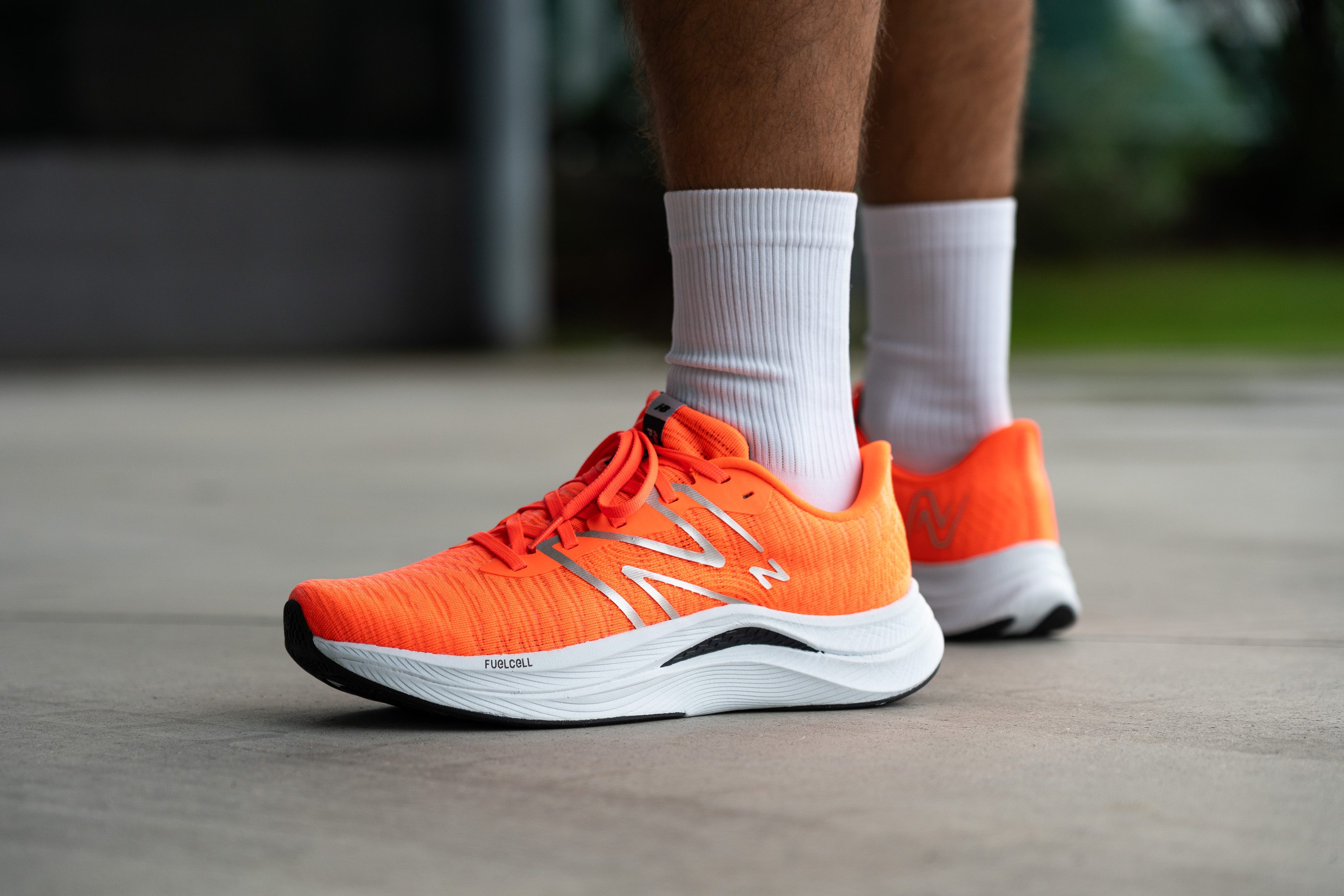
Who should NOT buy
The Propel v4 delivers a soft, cloud-like experience, and that's not for everyone. If you prefer a firmer and more stable run, check out alternatives like the Saucony Tempus or the Puma Deviate Nitro 2, as we consider these to offer a better fit for such preferences.
With a 4.5-mm heel-to-toe drop, this shoe doesn't shine for heel strikers, especially those in need of stability features. In such cases, we found the Brooks Hyperion GTS or the ASICS Gel Kayano 30 could be a more fitting choice.
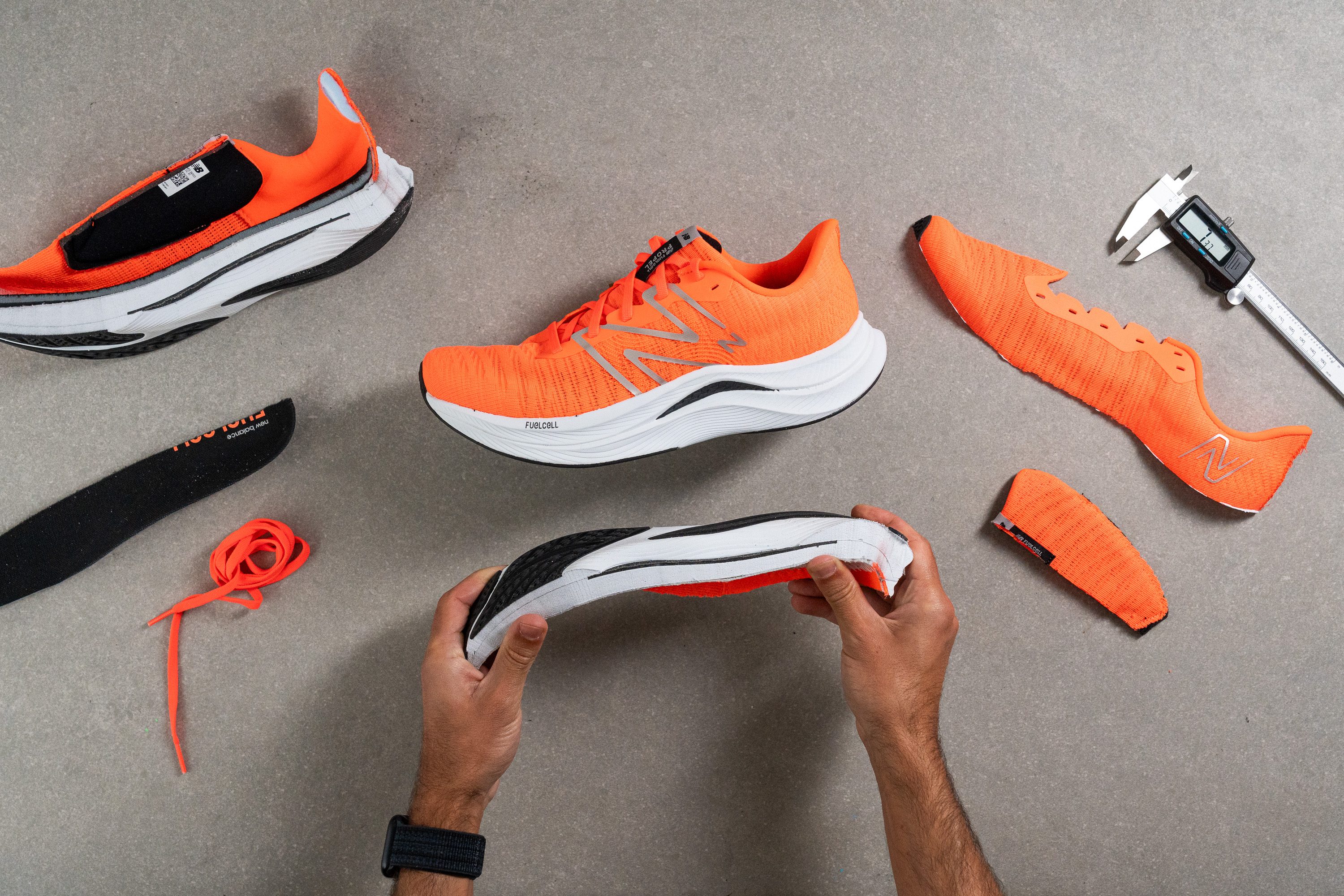
Cushioning
Shock absorption
One of the standout traits of the Propel is its all-distance versatility—perfect for short bursts, mid-range sessions, and long runs alike. That’s mainly due to its fantastic shock absorption, which we measured at 136 SA in our lab.

| FuelCell Propel v4 | 136 SA |
| Average | 129 SA |
Energy return
Energy return is decent at 58.6% in the heel. The forefoot delivers a slightly more responsive ride at 62.8%. These are solid figures for such an affordable shoe, making it a great choice for beginners.
| FuelCell Propel v4 | 58.6% |
| Average | 58.6% |
Heel stack
Moving to the midsole, we measured a heel stack height of 33.7 mm. This clearly shows that the Propel v4 isn't aiming for the sky-high cushioning of a maximalist shoe, staying well under the 40 mm mark.
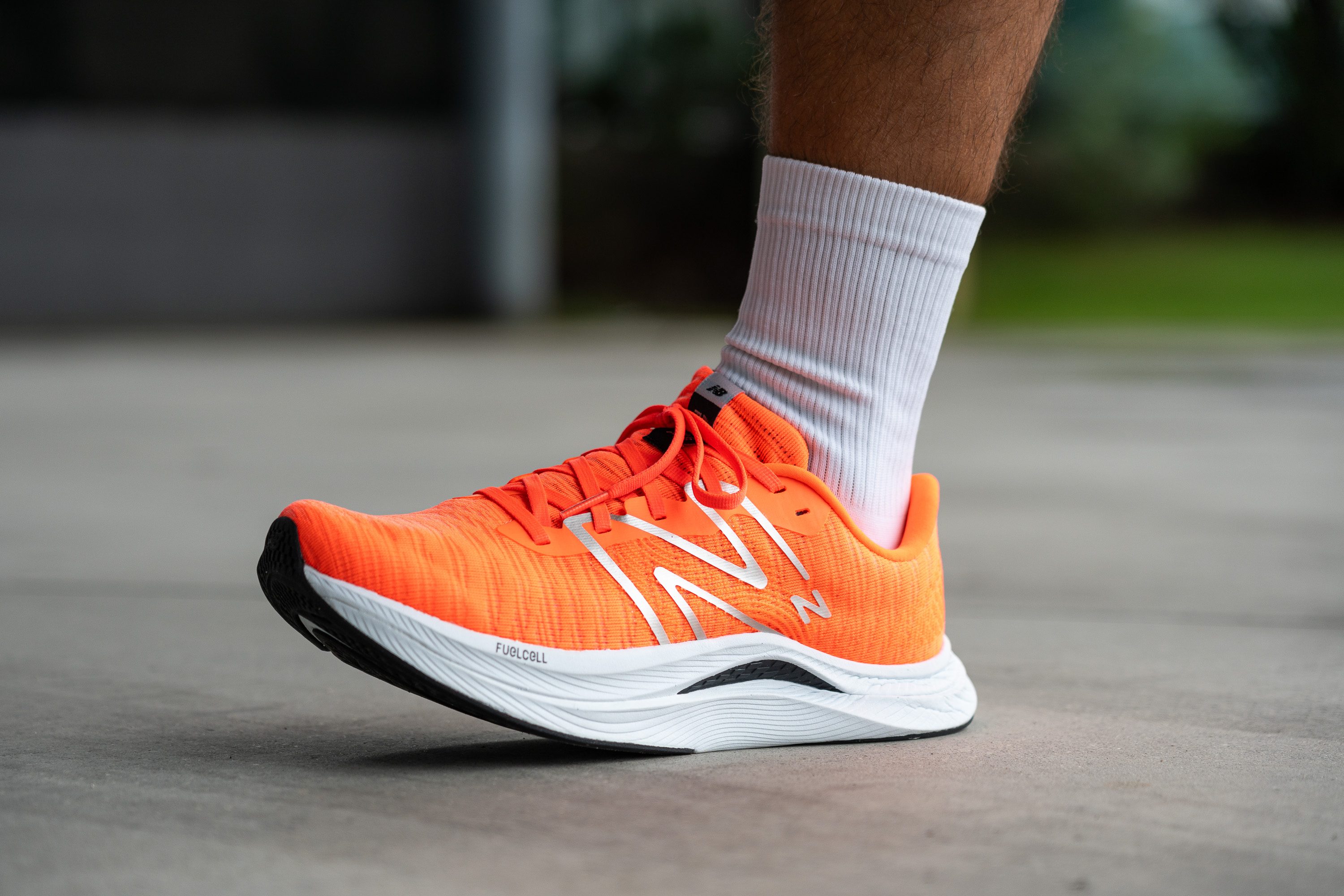
But don't let that fool you—the stack height still provides enough cushioning for even your longest runs.
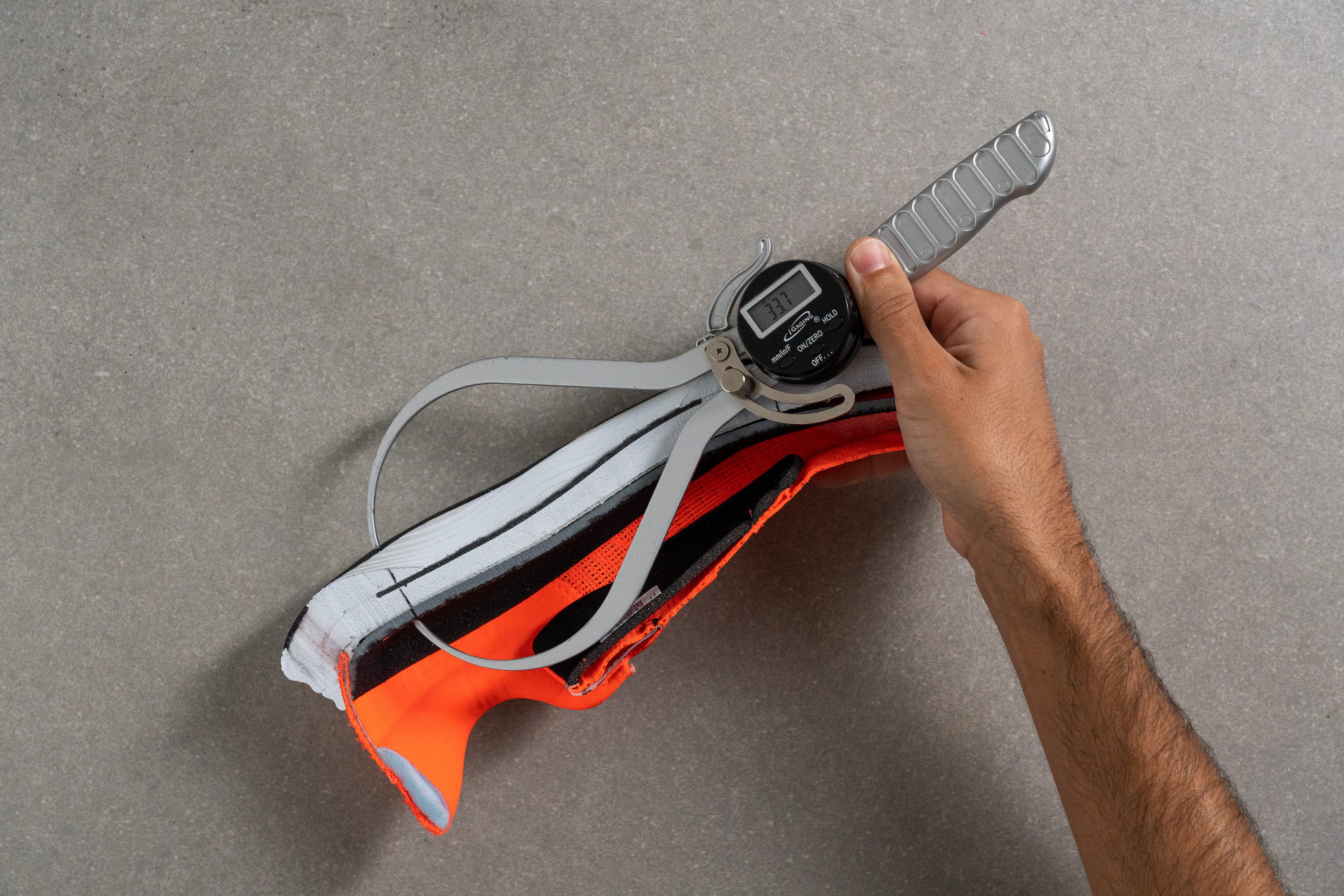
| FuelCell Propel v4 | 33.7 mm |
| Average | 34.8 mm |
Forefoot stack
We measured the forefoot stack and found that it sits at a comfortable 29.2 mm. This is a clear sign from New Balance that the Propel v4 is specifically designed for those who are midfoot and forefoot strikers.

| FuelCell Propel v4 | 29.2 mm |
| Average | 26.2 mm |
Drop
We just mentioned this shoe isn't really geared toward heel strikers. The 4.5-mm heel-to-toe drop serves as proof. While the shoe is user-friendly for everyone, it really shines for those who land on the midfoot or forefoot.
It's worth noting that New Balance lists a 6-mm drop in their specs. But after multiple measurements, all in line with official World Athletics guidelines, we can confirm the drop is actually 1.5 mm less than that.
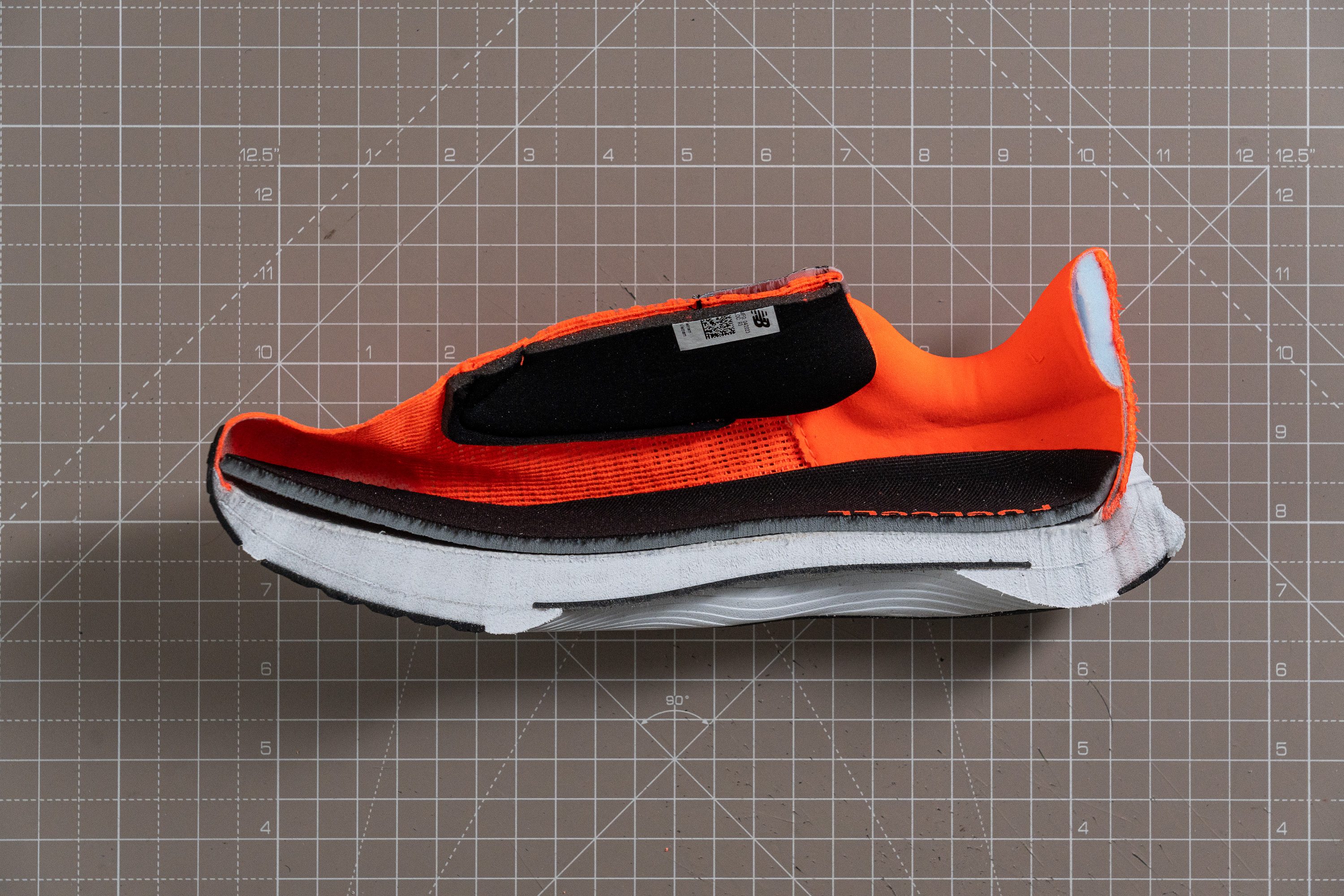
| FuelCell Propel v4 | 4.5 mm |
| Average | 8.6 mm |
Midsole softness
New Balance's FuelCell foam is a top pick for anyone who loves that soft, cloud-like cushioning. In the Propel v4, this comfort-focused trend keeps going. We gauged its softness at only 14.0 HA using our lab's durometer.
This foam squishes down super easily, making it ultra-comfortable. Plus, the built-in TPU plate in the midsole helps with smooth step-to-step transitions. This also keeps the shoe from bottoming out, which can sometimes be a problem with FuelCell shoes.
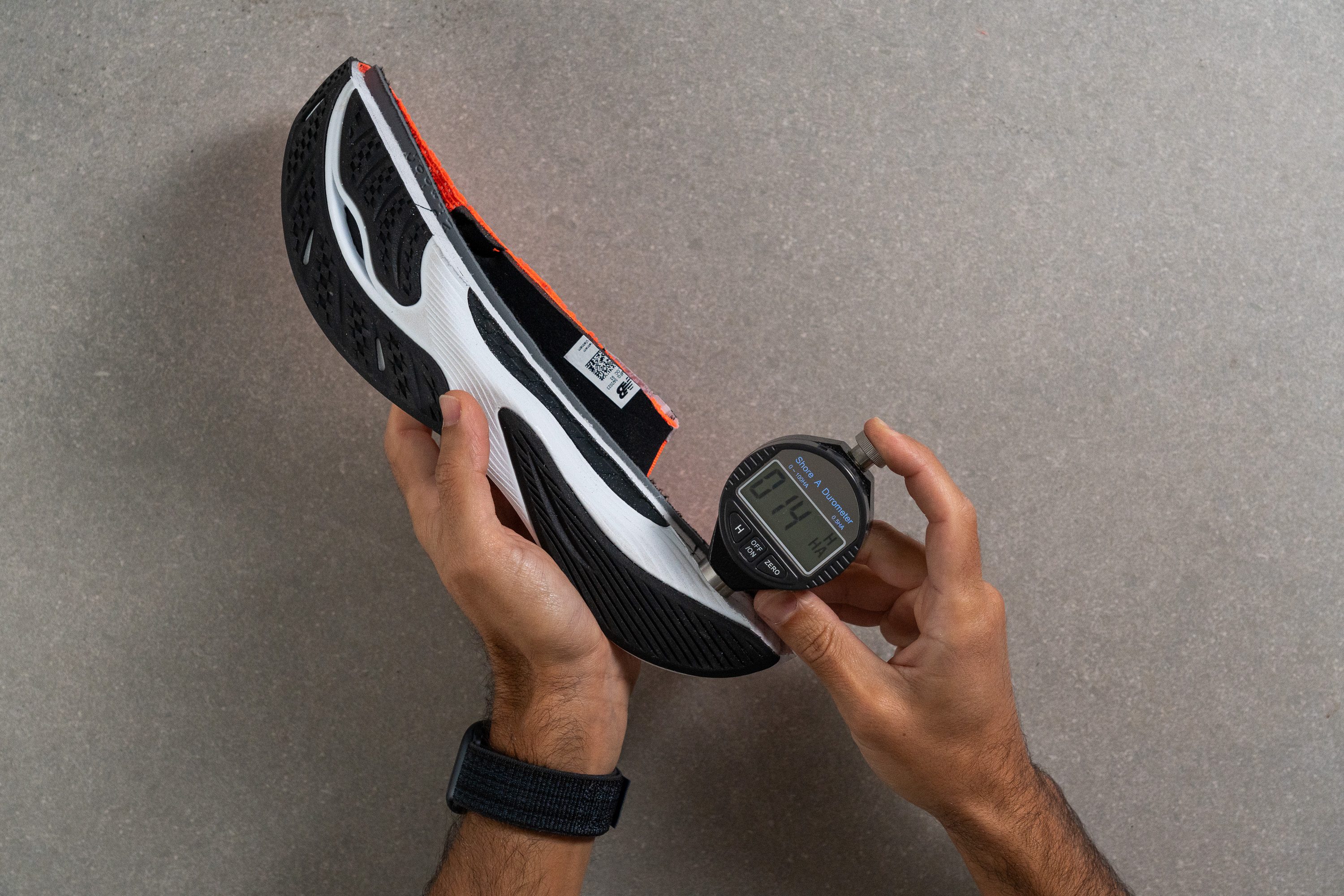
| FuelCell Propel v4 | 14.0 HA |
| Average | 20.4 HA |
Size and fit
Size
New Balance FuelCell Propel v4 fits true to size (111 votes).
Width / Fit
We initially thought that New Balance would pair the wide midsole of the Propel v4 with a spacious upper. Surprisingly, we discovered that the upper is actually medium-to-narrow. So why did they go this route?
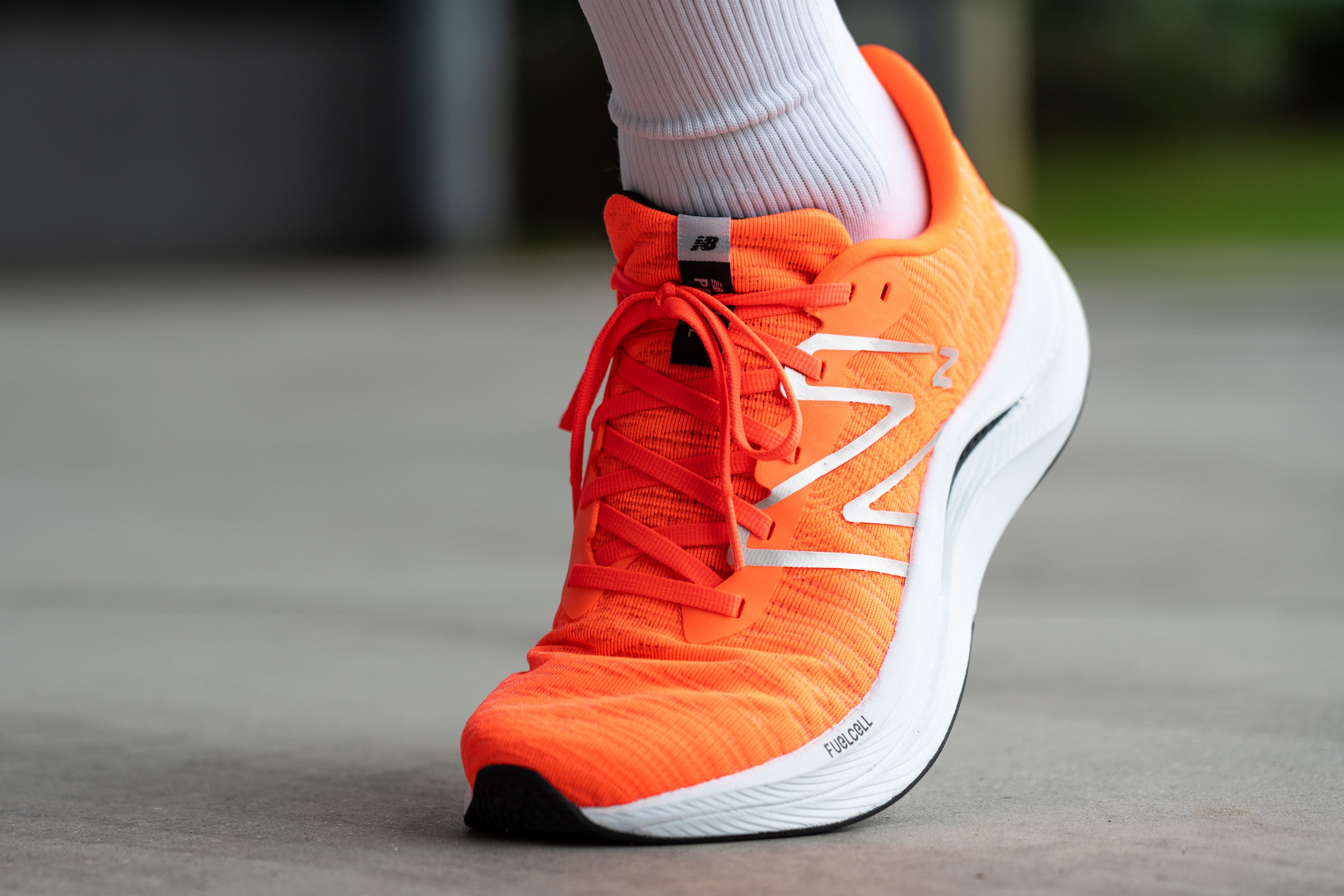
We found two main reasons behind this design choice. First, the Propel v4 is available in wide size. So if you're looking for a roomier upper, you have that option. Second, a narrower upper combined with a wide midsole actually improves stability—it's a clever little trick to enhance performance.

This test follows an older methodology, which is why you don't see recently tested shoes in the chart. Results from different methodologies can not be compared.
| FuelCell Propel v4 | 97.3 mm |
| Average | 98.5 mm |
Toebox width
After taking another measurement focused on the big toe area, we were pleasantly surprised.
New Balance has bucked the trend by designing a remarkably rounded fit with a generously wide toe cap (79.1 mm). We're really impressed and appreciate it.
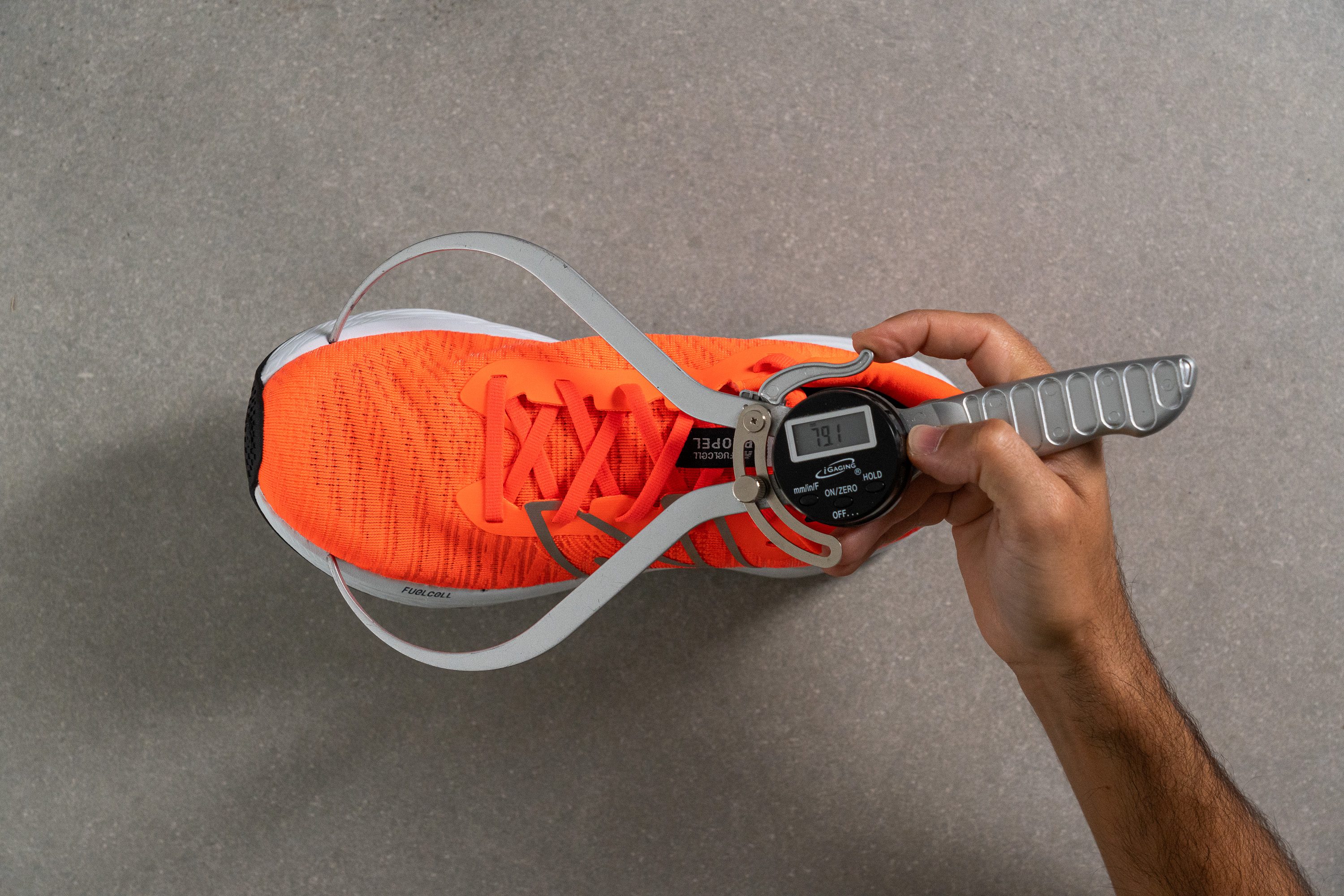
This test follows an older methodology, which is why you don't see recently tested shoes in the chart. Results from different methodologies can not be compared.
| FuelCell Propel v4 | 79.1 mm |
| Average | 78.4 mm |
Traction / Grip
Traction test
| FuelCell Propel v4 | 0.48 |
| Average | 0.48 |
Outsole design
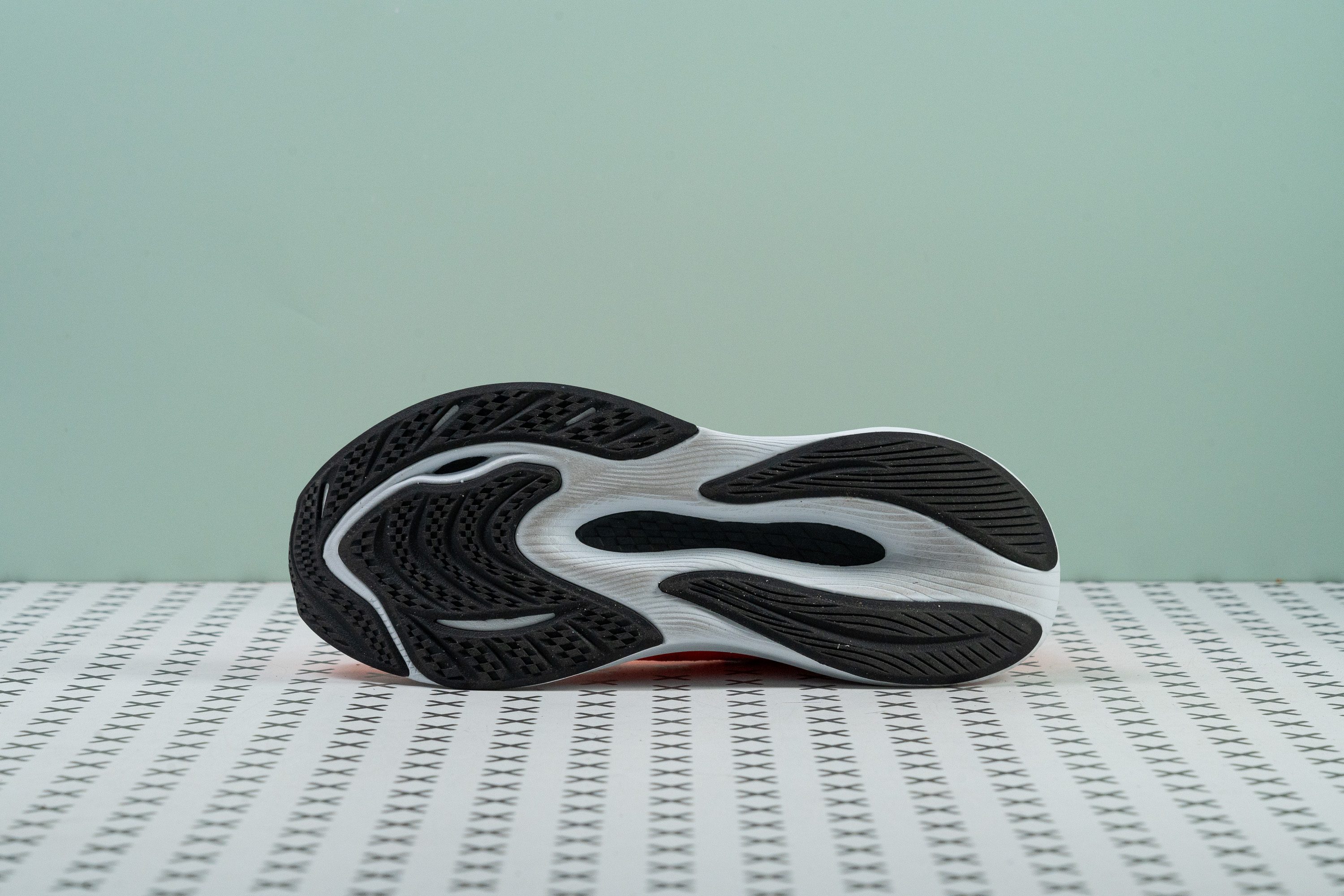
Flexibility / Stiffness
With a TPU plate in the midsole, we initially thought the shoe would be on the stiffer side.
However, in our lab's bend test—where we apply force until the shoe bends at a 30-degree angle—we only needed to use 12.6N of force. This shows that the plate doesn't make the Propel feel too stiff, which is actually a good thing for a training shoe.
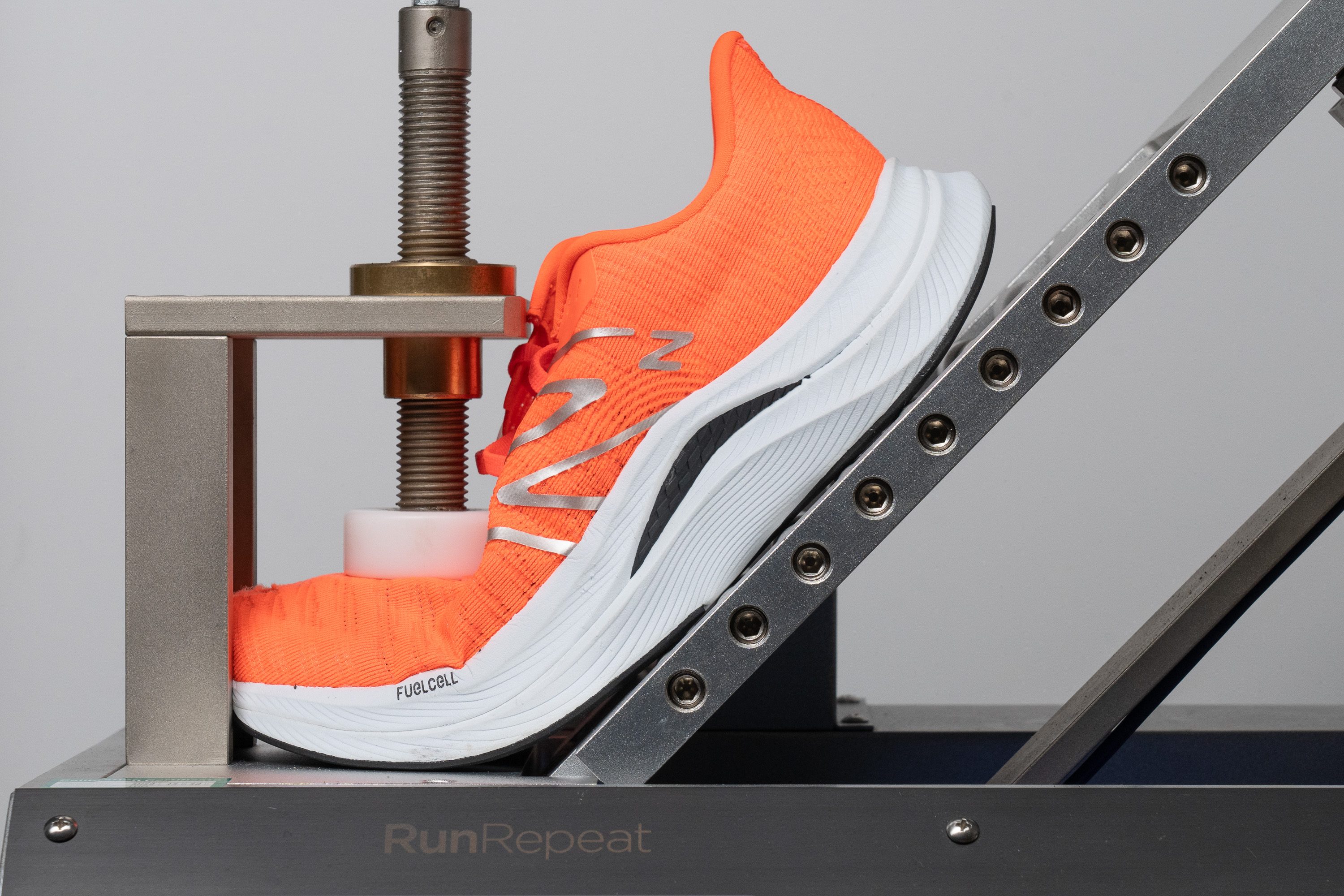
| FuelCell Propel v4 | 12.6N |
| Average | 15.3N |
Stiffness in cold (%)
After chilling the shoe in the freezer for 20 minutes, we did the bend test again. Impressively, the result was almost identical at 26.3N.
That's only a 6% difference which highlights the shoe's consistent stiffness, even in colder conditions.
| FuelCell Propel v4 | 6% |
| Average | 33% |
Weight
Weighing in at 9.7 ounces or 276 grams, this shoe isn't exactly a heavyweight, but it's also far from feather-light.
While it could stand to shed a few ounces, the culprit seems to be the thick upper that's designed for extra comfort and the FuelCell foam. This makes it noticeably heavier than other options out there, like the Saucony Endorphin Speed 3.

| FuelCell Propel v4 | 9.7 oz (276g) |
| Average | 9.3 oz (264g) |
Breathability
At first glance, the New Balance FuelCell Propel v4 doesn't seem like a shoe that would breathe well. The engineered mesh feels heavy and thick, and we don't see any obvious ventilation holes. So, we're not expecting much in terms of breathability.
But we love testing shoes rather than just guessing. Our eye-catching smoke test gave it a 4 out of 5 score. That's good enough to call it a well-ventilated shoe, even if it's not the best out there.
When we used a light and moved the upper, we found a nice surprise. There's airflow through the midfoot, which sets it apart from many shoes that only have ventilation in the toe box.
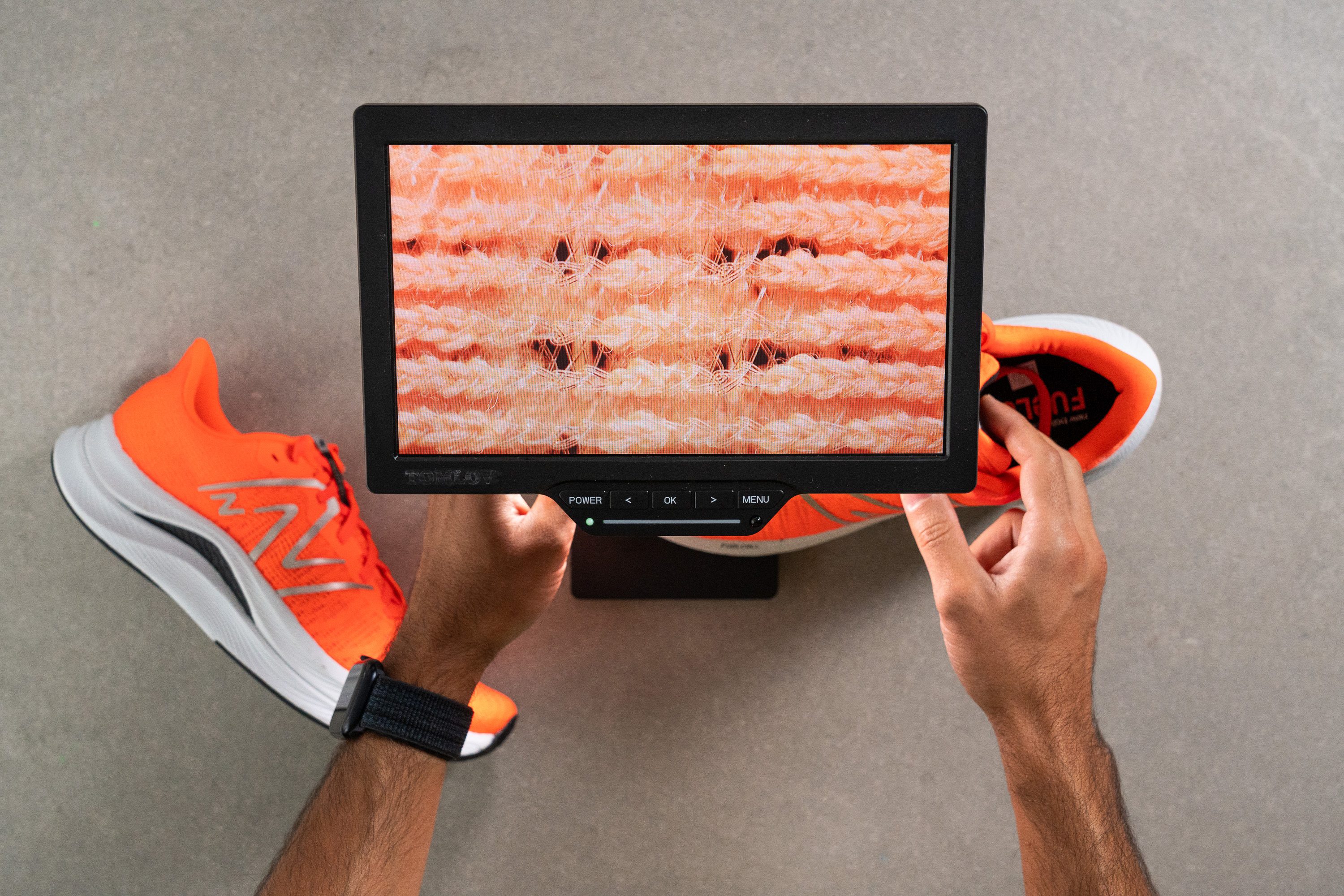
Finally, a closer look under the microscope confirms our findings. We see the same multi-layered mesh we noted earlier. But now, we also spot some small ventilation holes that explain the better-than-average score.
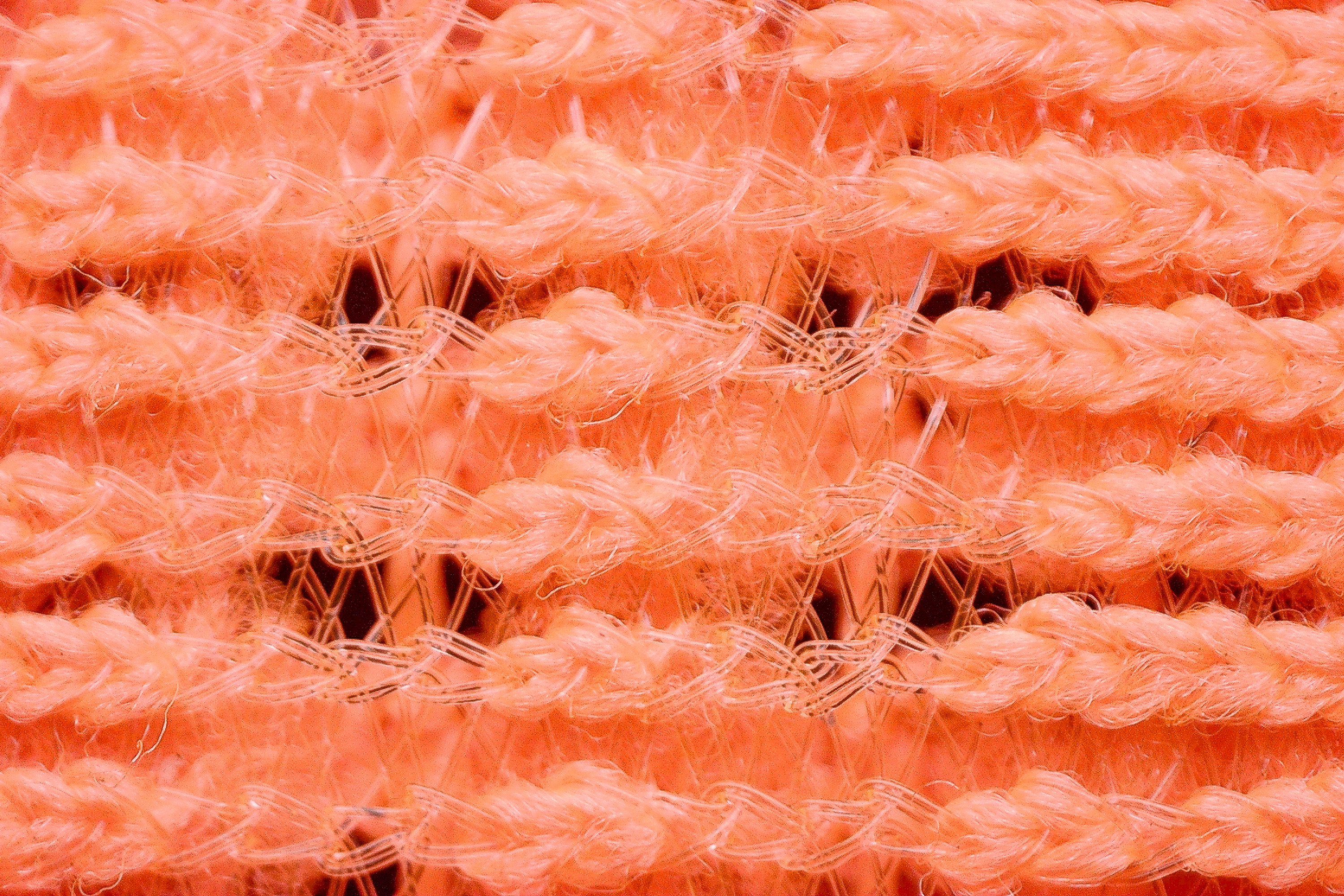
The standout feature of this upper is unquestionably its high quality. You'd expect to find something like this in a shoe priced around $150, not one that costs just $110.
| FuelCell Propel v4 | 4 |
| Average | 3.7 |
Stability
Lateral stability test
If you're looking for a shoe that's good for fast-paced runs and offers stability, the Propel v4 isn't for you, check the ASICS Superblast instead—but yes, it costs $200.
The soft foam and non-supportive upper make this a no-go for people who pronate. However, it's a fantastic fit for neutral runners.
Torsional rigidity
The TPU plate in the midsole really stiffens up the shoe. We had to apply a lot of force to twist it in our lab tests. That earns it a solid 4 out of 5 score!
| FuelCell Propel v4 | 4 |
| Average | 3.5 |
Heel counter stiffness
The heel counter is comfy yet fairly firm, but it's not like what you'd find in a stability-focused shoe. In our tests, we gave it a middle-of-the-road 3 out of 5 score.
| FuelCell Propel v4 | 3 |
| Average | 2.9 |
Midsole width - forefoot
Understanding that a soft foam and a flexible upper could make the shoe wobbly, New Balance designers chose a wide design (116.2 mm) to make it more stable. This approach does help to some extent.
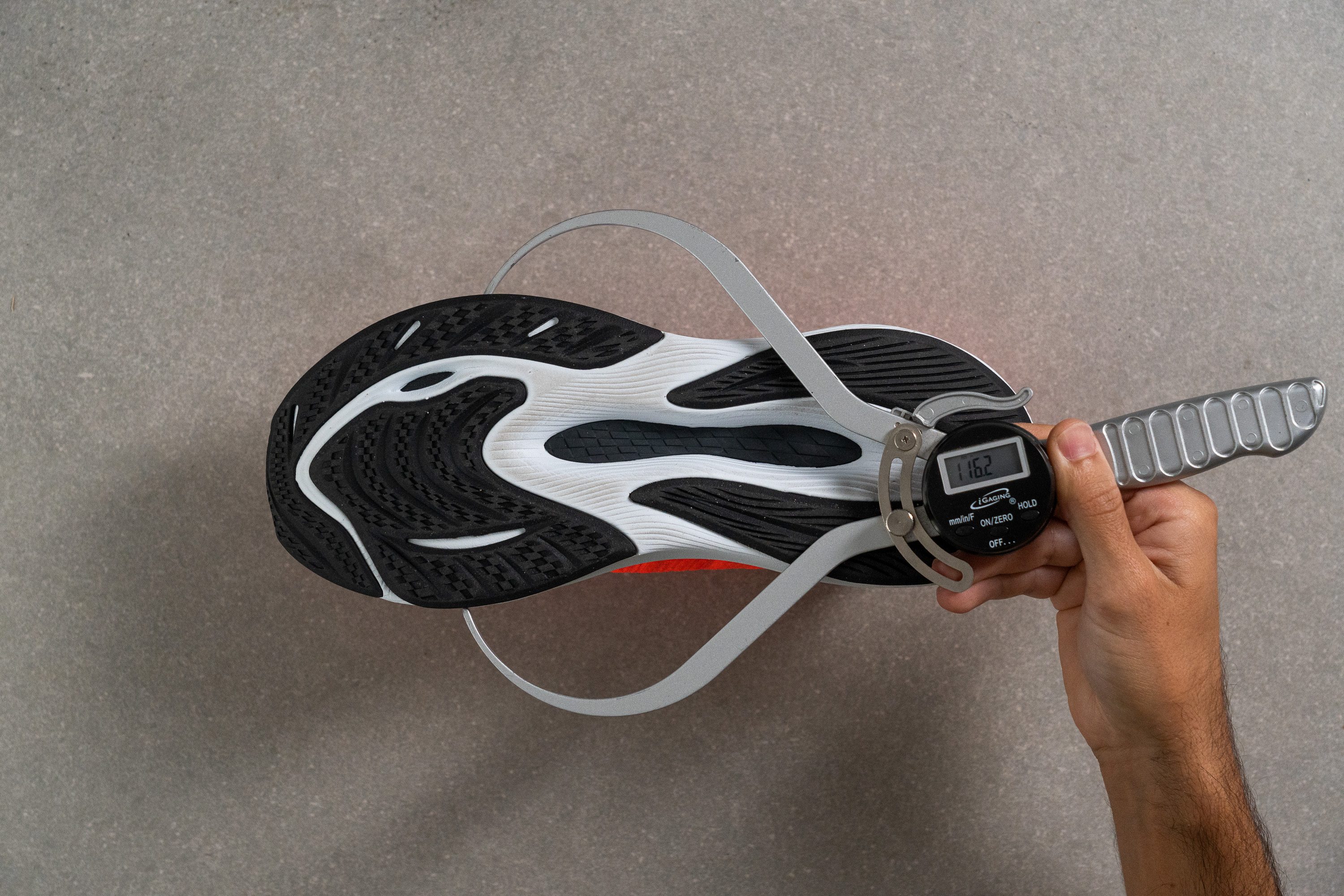
| FuelCell Propel v4 | 116.2 mm |
| Average | 114.4 mm |
Midsole width - heel
We measured the heel width and found it to be 97.6 mm, which is noticeably wider than what you'd see in most running shoes.
It's an interesting choice, considering the shoe isn't really aimed at heel strikers. It looks like New Balance is trying to make a shoe that appeals to everyone...

| FuelCell Propel v4 | 97.6 mm |
| Average | 90.7 mm |
Durability
Toebox durability
An unexpected perk of uppers that don't ace our breathability test is that they often turn out to be more durable. That's exactly what we find with the Propel v4, which earns a solid 2/5 score in our Dremel test.
When we compare it to the ASICS GT 1000 12 in the picture below, the difference is crystal clear.
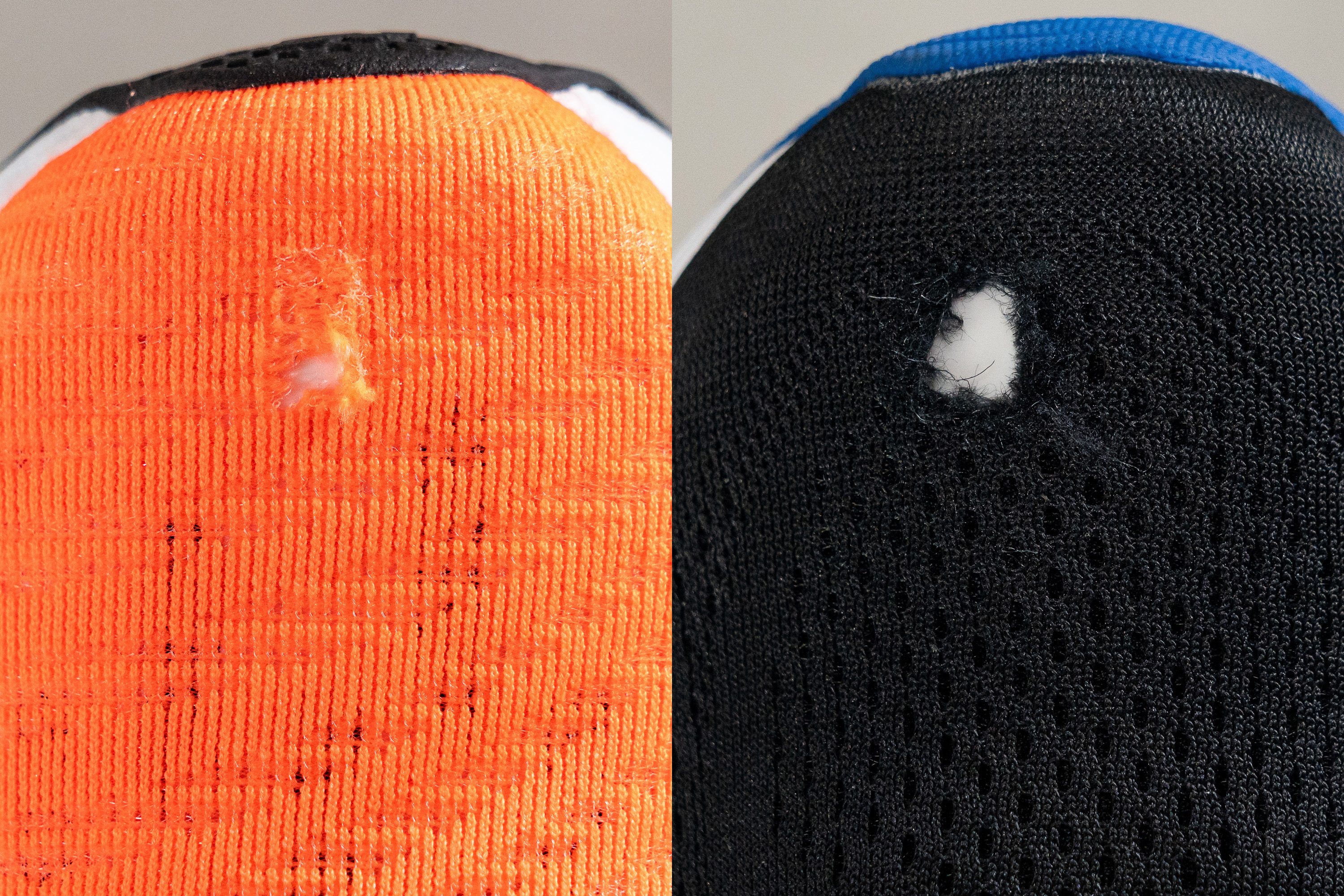
| FuelCell Propel v4 | 2 |
| Average | 2.6 |
Heel padding durability
Next, we turned our attention to the heel area to assess its durability, and let's just say our jaws dropped at the findings.
We could barely see any wear on the heel, making us thrilled to award one of the rare 5/5 scores ever.
In fact, we had been pretty critical about the disappointing durability of some NB shoes like the Rebel v3 (right). But it looks like New Balance really stepped up their game.
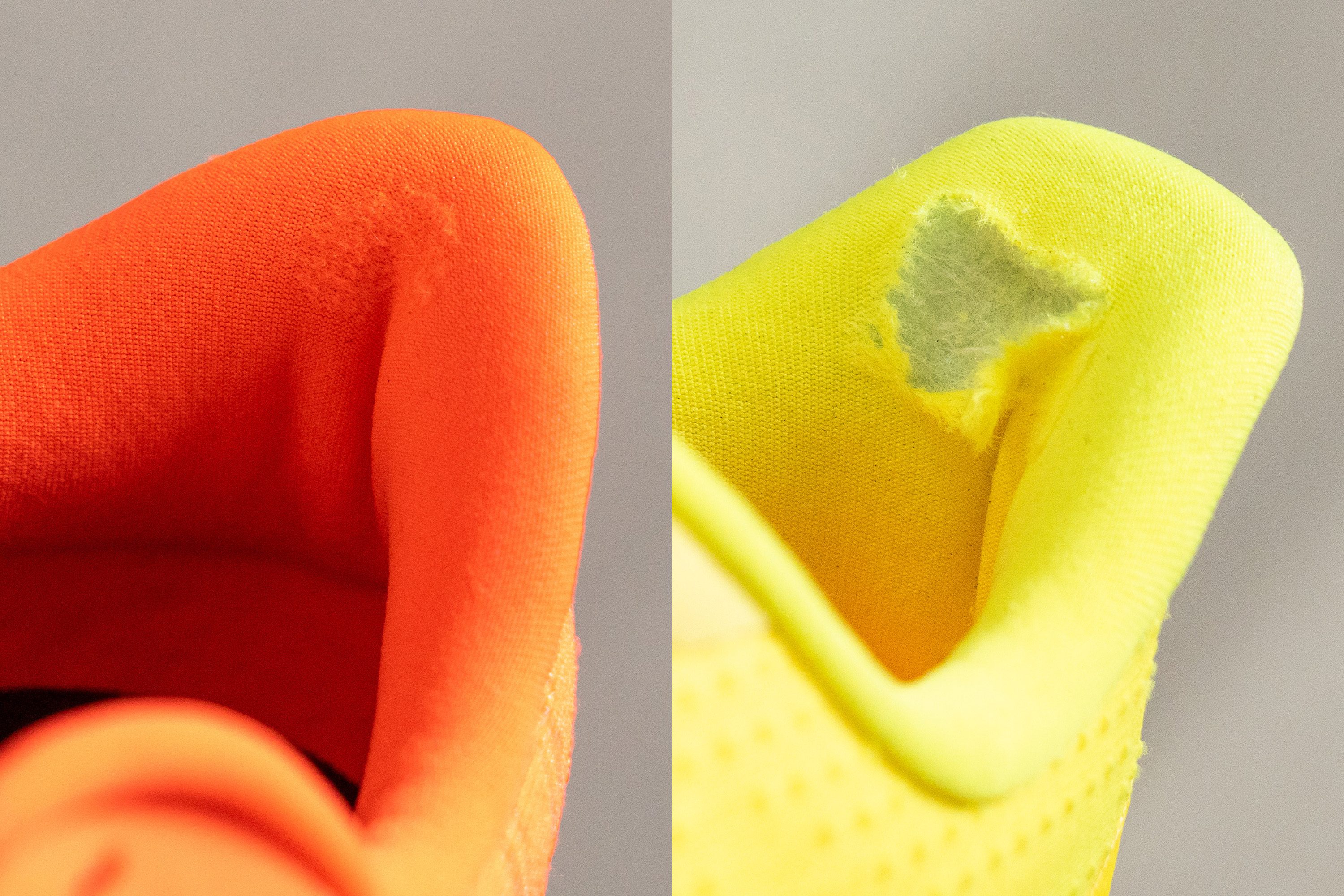
| FuelCell Propel v4 | 5 |
| Average | 3.4 |
Outsole durability
The ultimate test for the outsole's durability came when we used our Dremel on it.
After putting the rubber through this rigorous test, we discovered just a minimal 0.5-mm indentation. That's an outstanding result, promising superb long-term durability for the shoe.

| FuelCell Propel v4 | 0.5 mm |
| Average | 1.1 mm |
Outsole thickness
The strong performance in our earlier test is likely why New Balance decided to go with a thinner-than-average outsole, helping to cut down the shoe's weight.
When we measured it, the outsole was just 2.5 mm thick, which is less than what you'd typically find in daily running shoes.
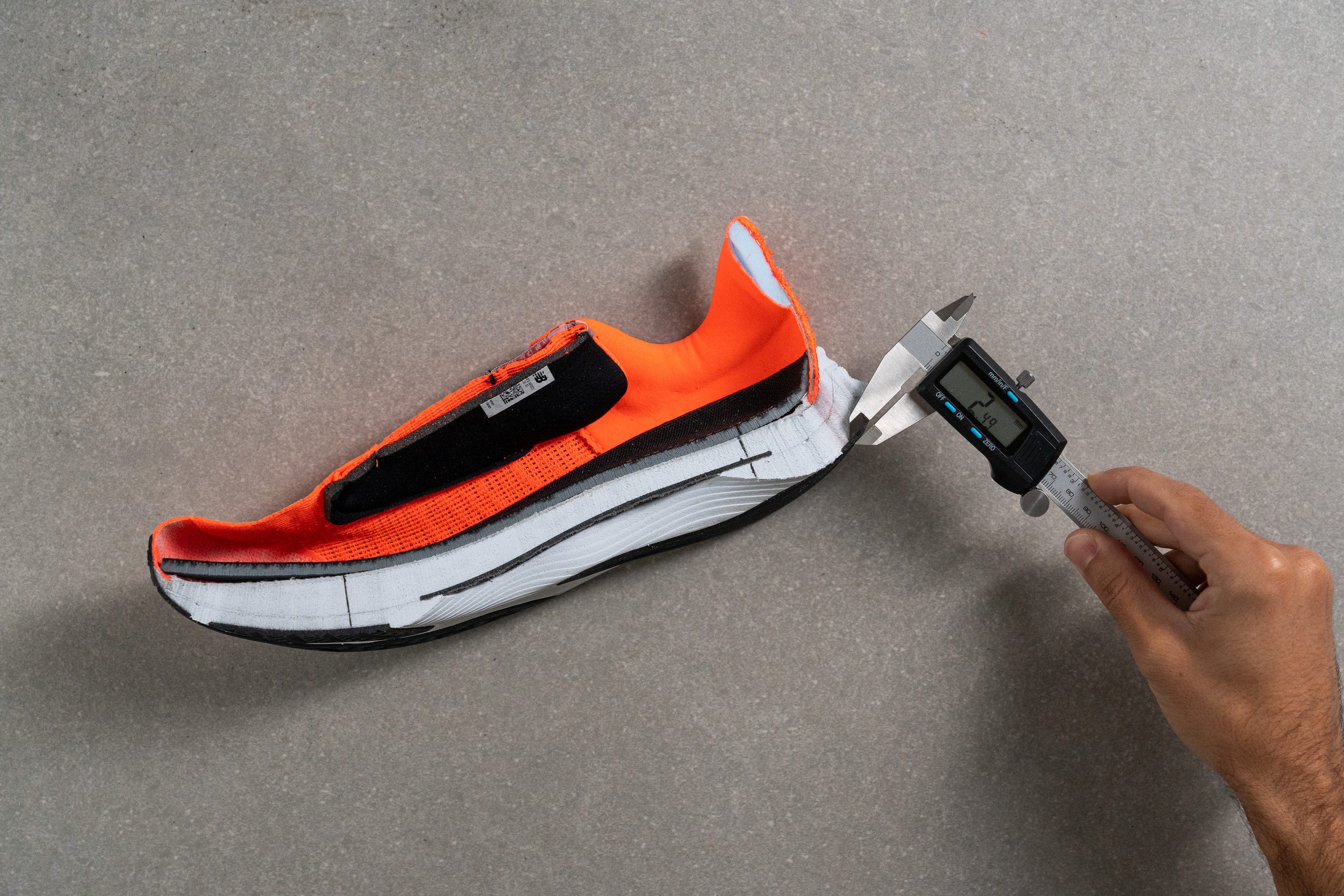
| FuelCell Propel v4 | 2.5 mm |
| Average | 3.2 mm |
Misc
Insole thickness
The insole is pretty standard with a thickness of 4.5 mm. There's really nothing special to point out—it's just a solid, straightforward insole!
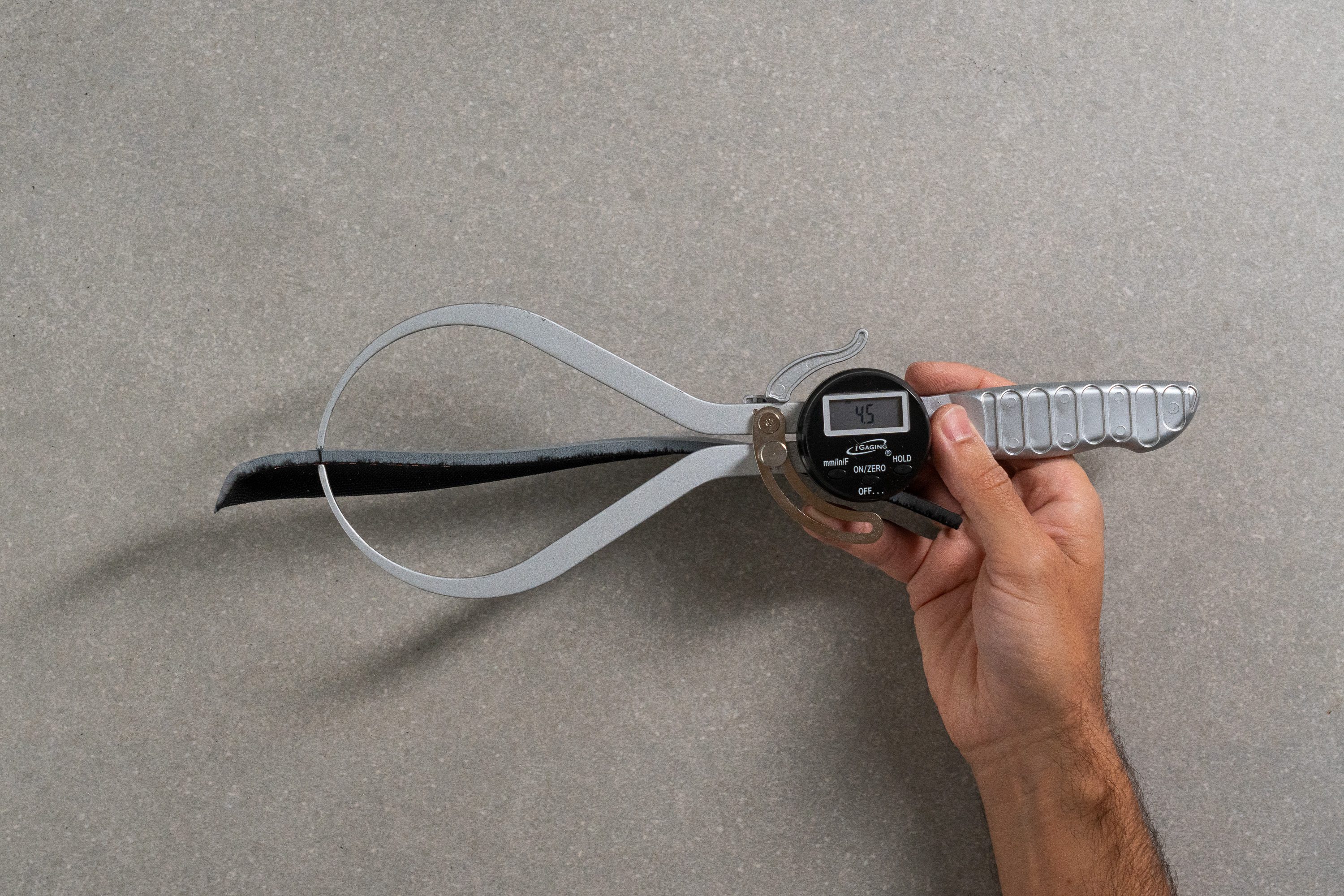
| FuelCell Propel v4 | 4.5 mm |
| Average | 4.5 mm |
Removable insole
The New Balance FuelCell Propel v4 has a non-glued insole that you can take out. We've easily swapped it with insoles from other shoes and even fitted custom orthotics without a problem.
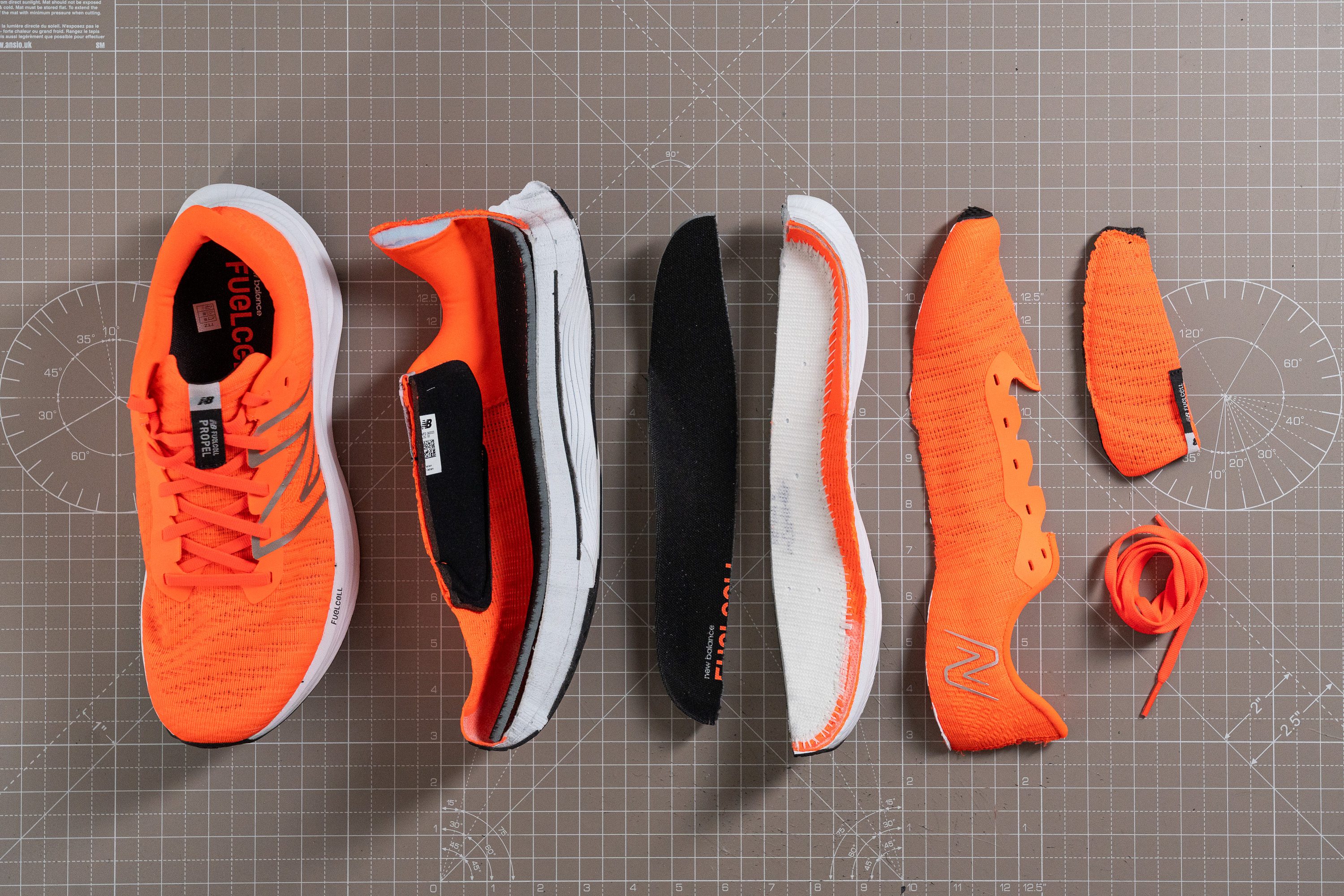
| FuelCell Propel v4 | Yes |
Midsole softness in cold (%)
FuelCell foam doesn't do great in cold weather, something we've mentioned in this advanced guide.
Yet, even after 20 minutes in our lab's freezer, the foam stays pretty soft and squishy. We ran the same test again and found that the durometer gave us an 18.8 HA reading.
We observed a 33.9% jump in stiffness, something you'll really feel if you live in places with harsh winters. This isn't great performance by any means.
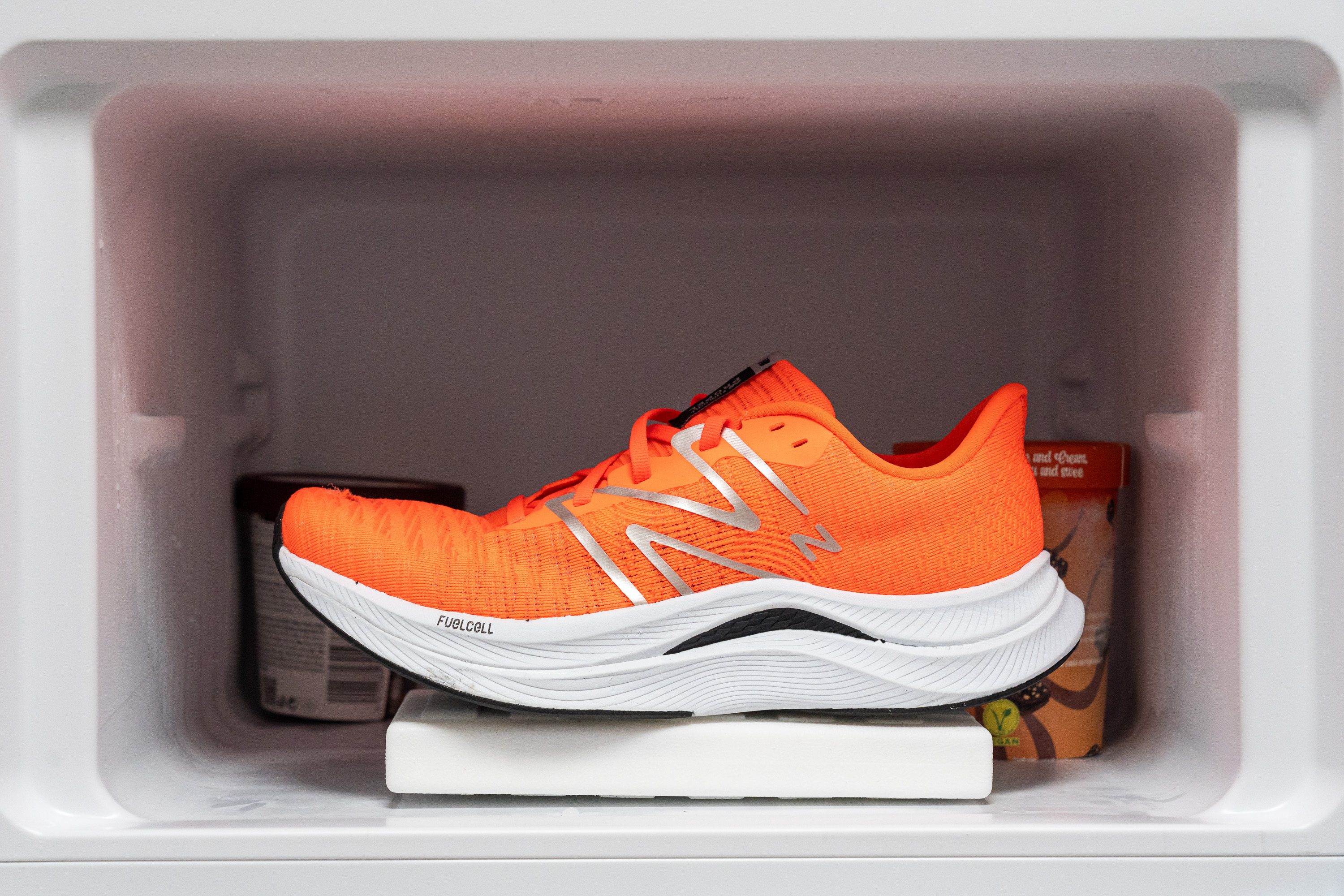
| FuelCell Propel v4 | 34% |
| Average | 24% |
Reflective elements
The Propel v4 disappoints us by lacking any reflective elements. For the next version, we think that New Balance can add a reflective big N logo. It would be a win-win for everyone!

| FuelCell Propel v4 | No |
Tongue padding
If weight isn't a big deal for you, then you'll find the tongue super comfy and well-padded. But it does add some extra ounces.
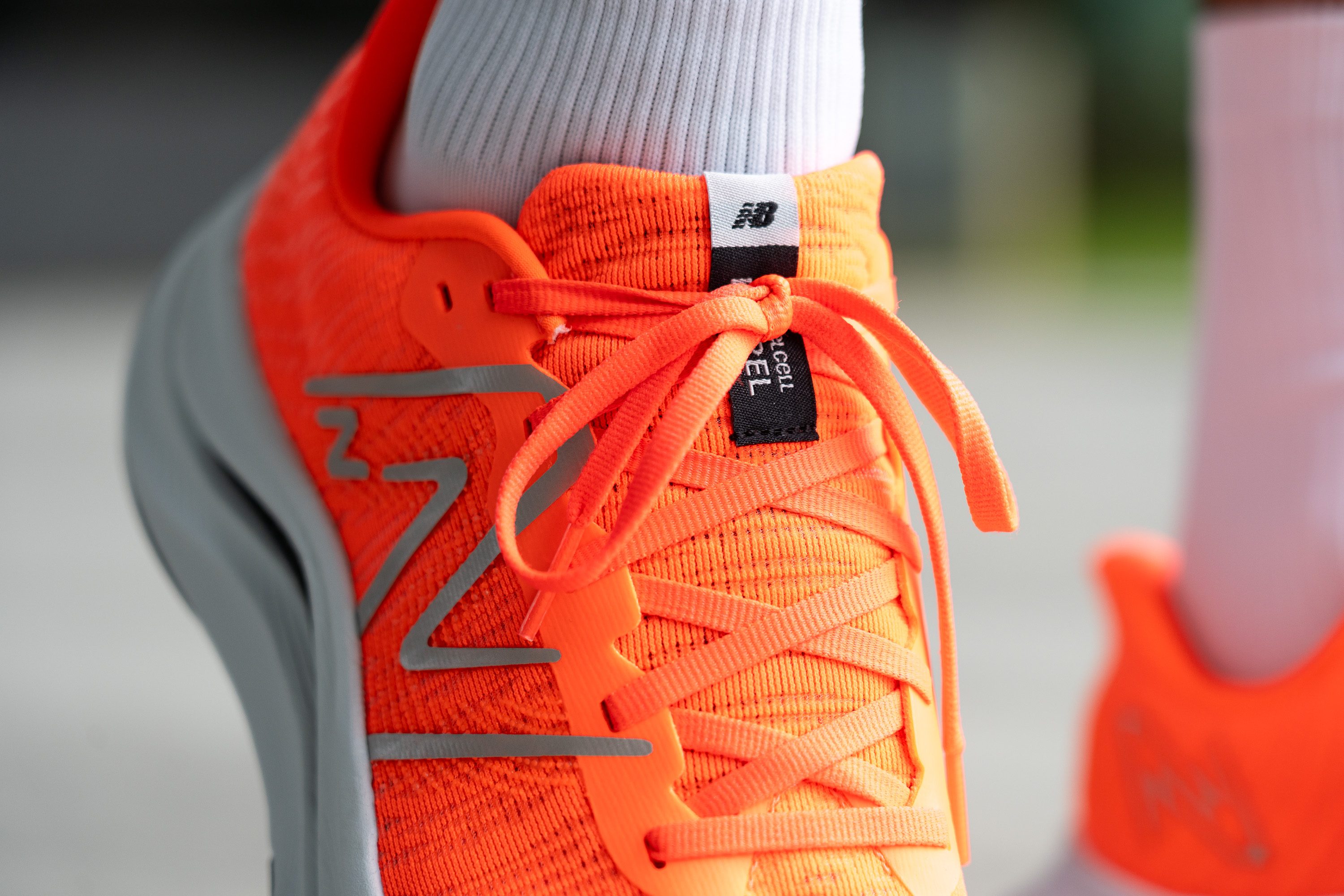
We think the tongue is one of the first spots where New Balance could cut weight for the next Propel model.
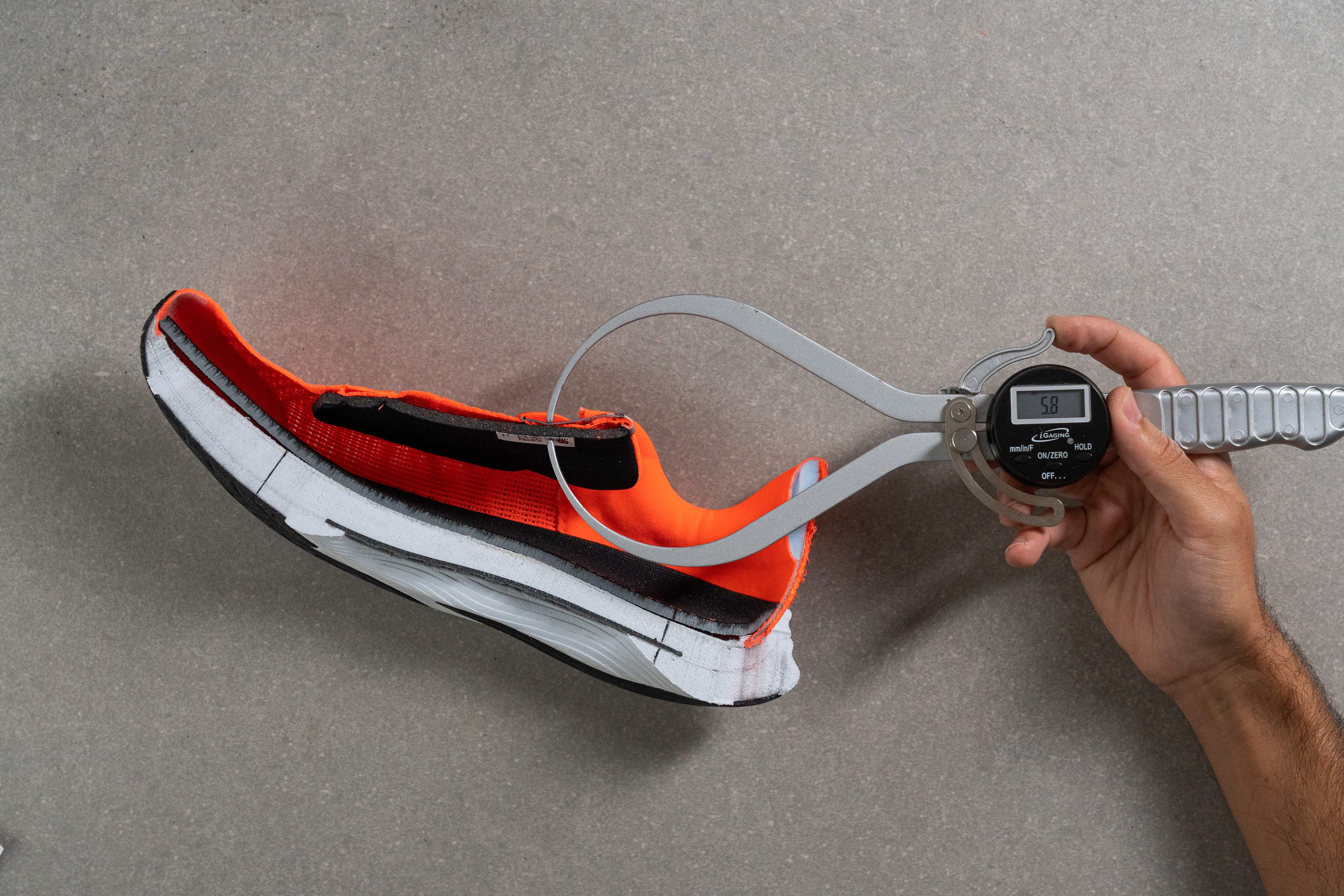
| FuelCell Propel v4 | 5.8 mm |
| Average | 5.8 mm |
Tongue: gusset type
Given all the high-end features we've talked about, we didn't expect to see a gusseted tongue in a shoe priced at $110. You can't get a top-of-the-line running shoe without paying top-of-the-line prices, after all.
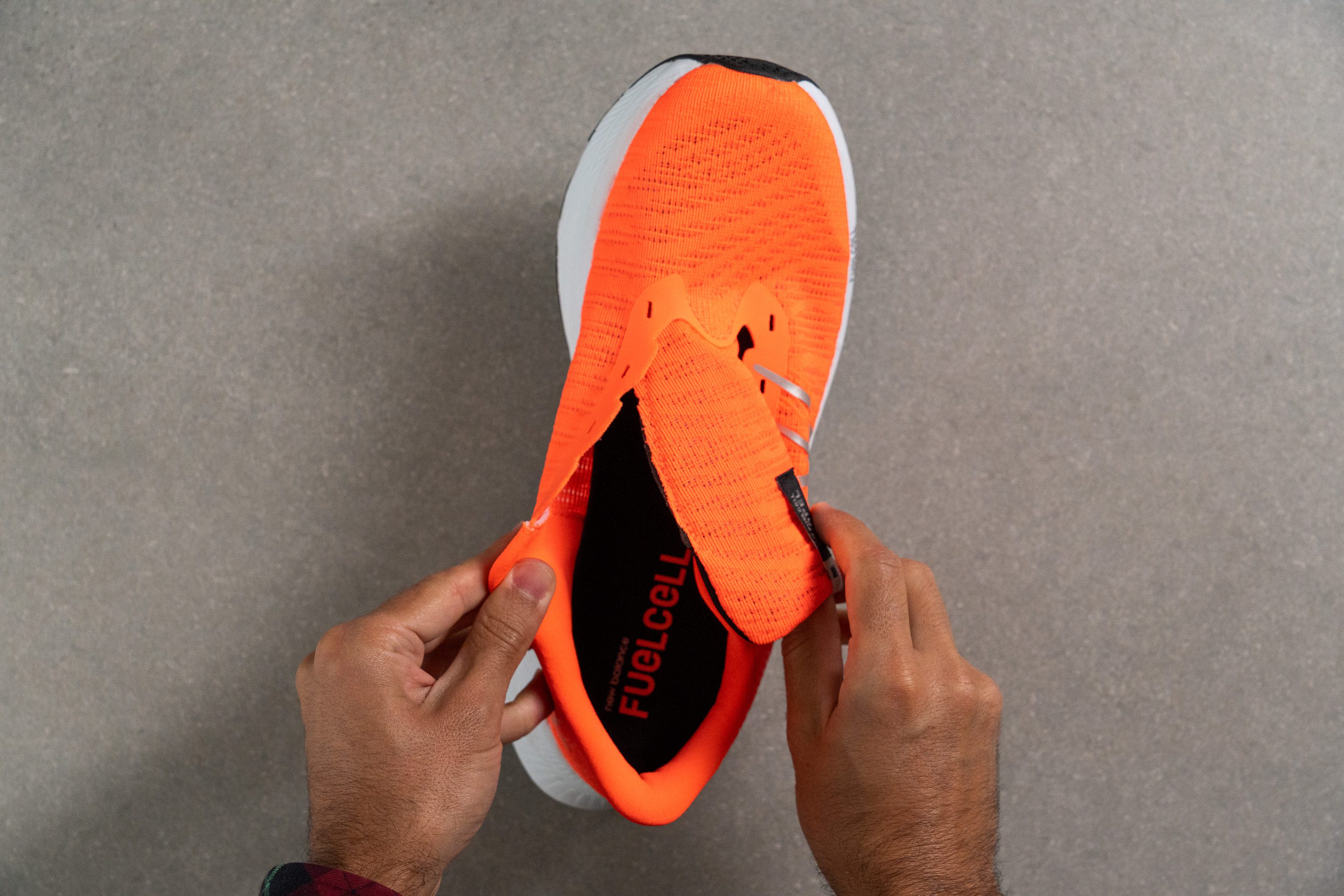
| FuelCell Propel v4 | None |
Heel tab
Lots of brands are getting rid of heel tabs in their shoes, and New Balance is doing the same with the Propel v4.
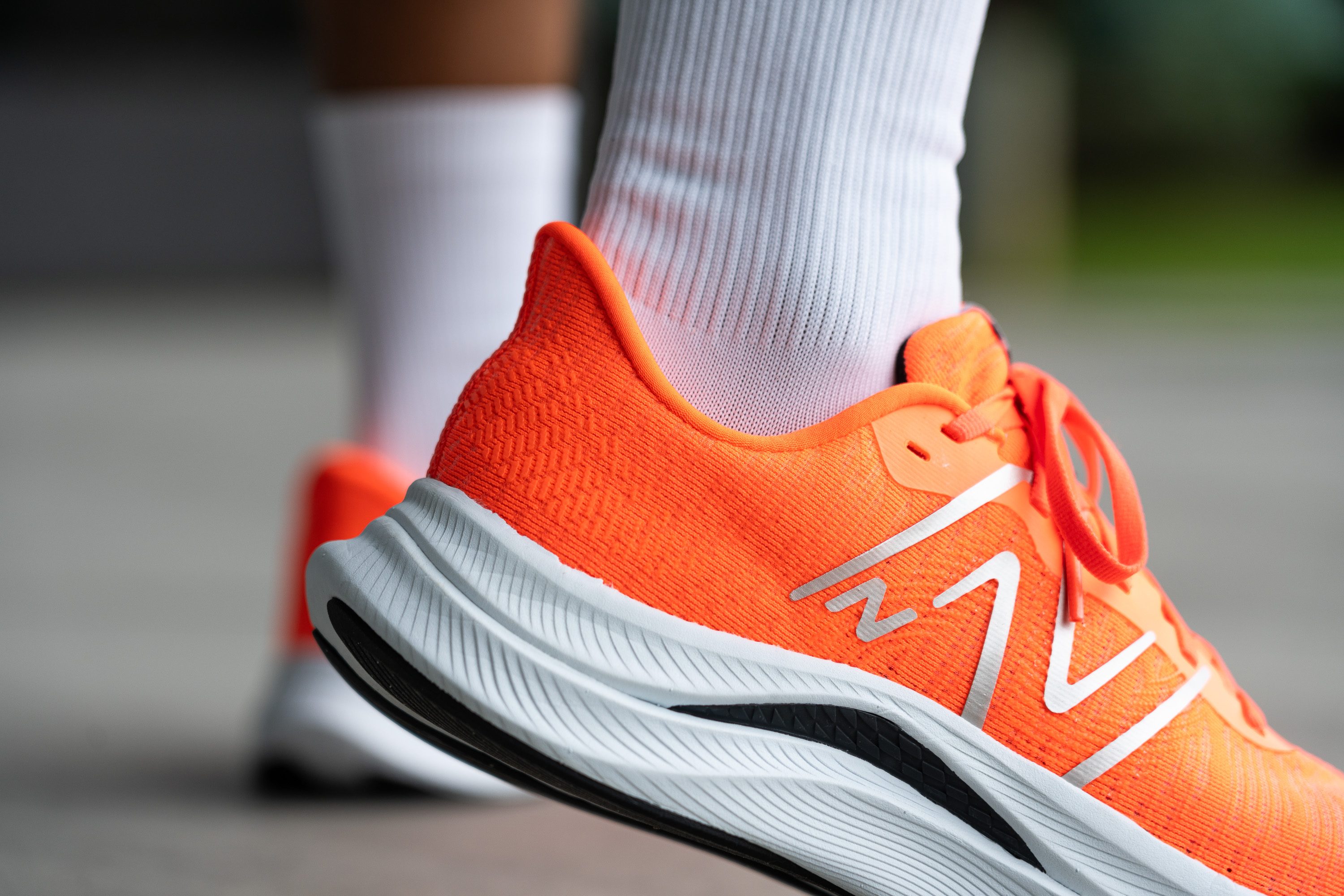
| FuelCell Propel v4 | None |

